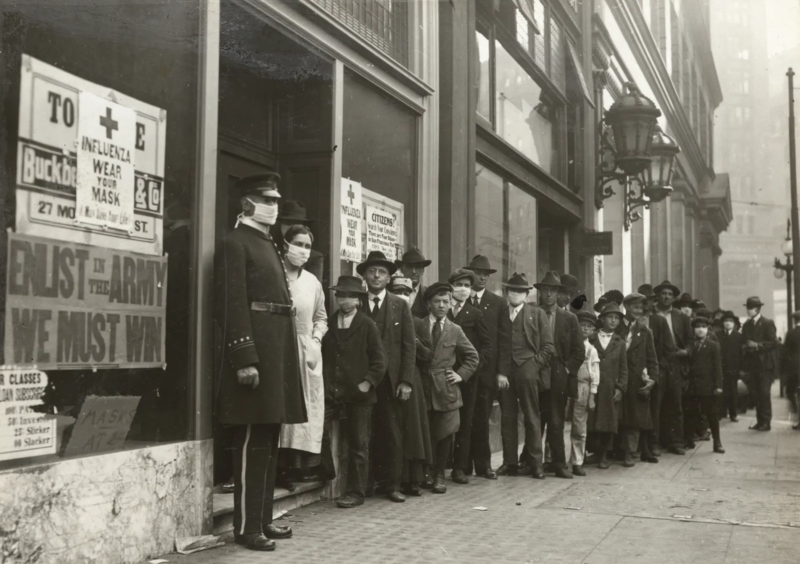
America’s Modern Parallels with 1918’s Anti-Mask League
Since the Coronavirus first reared its ugly head earlier this year, there has been a severe backlash by some citizens in America against measures put in place to protect them. This might appear strange, but as with most situations, history has seen it all before. Specifically, in the form of the Anti-Mask League.
1918
Almost exactly a century ago, the H1N1 influenza of 1918-19 swept the globe in similar fashion to Covid-19. The most severe pandemic in recent history, the great influenza, or Spanish flu, infected roughly a third of the world’s population and took the lives of at least 50 million. With no vaccination or antibiotics to treat the secondary bacterial infections commonly associated with the new disease, non-pharmaceutical intervention was the only method of control.
The disease arrived in San Francisco in late September. Homes of the infected were placed under quarantine, but hospitals were still soon overwhelmed with patients. The city was shut down until further notice – a story with which we are all far too familiar.
What Accelerated the Infections?
Widespread destruction from a severe earthquake in 1906 and weariness following World War 1 had created a general mood of municipal incompetence among the city’s residents. Therefore, when attempts were made by the authorities to encourage San Franciscans to cover their faces by prescribing it as ‘patriotic duty’, it is unsurprising that that duty was left unfulfilled. As a result, masks were made a legal requirement, but only on 25th October.
Second Spike
During the first bout of the disease, contempt for the mask law was high and ‘mask slackers’ filled the courts to their rafters. After a month of lockdown, the Mayor announced that the influenza had been stamped out. A premature reopening of society soon led to a deadly second wave of the disease. It was then that the masks became mandatory. It was also then, in response to this enforcement, that the Anti-Mask League was formed, after three unmasked protestors were shot by an overzealous health official.
The League’s first meeting garnered 2,000 spectators, with 4,500 members gathering on Dreamland skating rink in rebellion against the unconstitutional nature of the mask ordinance. It was argued that the death toll continued to rise despite the use of masks and that the obligation to cover one’s nose and mouth was an affront to the principles of a free society. Despite everything that was going on around them, they succeeded in their cause.
However, despite the protesters’ best efforts, masks were reinstated as a legal requirement on 16th January. Only ten days later, the infection rate had plummeted; the city had the disease under control. The goals of the League’s members then varied widely, from evoking the mandate to demanding the Mayor be fired. Ultimately, at their last meeting on January 26th, proceedings descended into chaos and the anti-mask league was disbanded. On 1st February, mask requirements were dropped for the second and final time.
Public Protest
Remarkable parallels can be seen between American public reaction to the 1918-19 influenza and the Coronavirus pandemic today. The first of these are the hives of protest seen around the US, in states such as Michigan, Oklahoma and Ohio.
Thousands of anti-mask league dissenters have gathered to protest against the stay-at-home order, asserting that it violates their constitutional rights. Protesters also say that keeping restrictions in place for too long will cause long-term damage to local economies, as the unemployment rate has soared to 36 million over the last two months. With many arriving at demonstrations heavily armed, the issue of encroachment upon second Amendment rights has also been raised.
‘Give me liberty or give me death’
Both instances of protest perfectly symbolise the fundamental, unchanging principle of Americanism – freedom from government intervention. It is exactly this form of negative liberty, as examined in depth by Isaiah Berlin, that the country was founded upon during the American Revolution. It remains so fundamental, that this section of society are willing to risk the health and safety of themselves and their families in the process of preserving it.
It is also this form of freedom from tyranny that President Trump embodies. In early April, the Centres for Disease Control and Prevention issued guidance recommending that people wear face masks in public settings where social distancing measures were not possible. However, Trump stated ‘I don’t think I’m going to be doing it… I just don’t see it’, having since been photographed standing proudly without a mask while touring mask production facilities, even as all those around him do otherwise. Thus, his refusal to comply with his own government’s guidelines suggests that he too is free from governmental interference.
It is therefore unsurprising that those organising protests are renowned right-wing Trump supporters. He has offered his tacit support to the activists on Twitter, writing ‘these are very good people’ and that ‘the Governor of Michigan should give a little’ on 1st May 2020, revealing his sympathy to the ideas and actions of the insurgents.
History’s Warning must be Heeded
Whether Trump genuinely supports the protesters or whether he is acting to ensure his voting base are on-side for the upcoming election, we cannot be sure.
But one thing is certain: if the people of America don’t return to normal life with caution, the second spike of 1919 may also be mirrored in today’s society.
